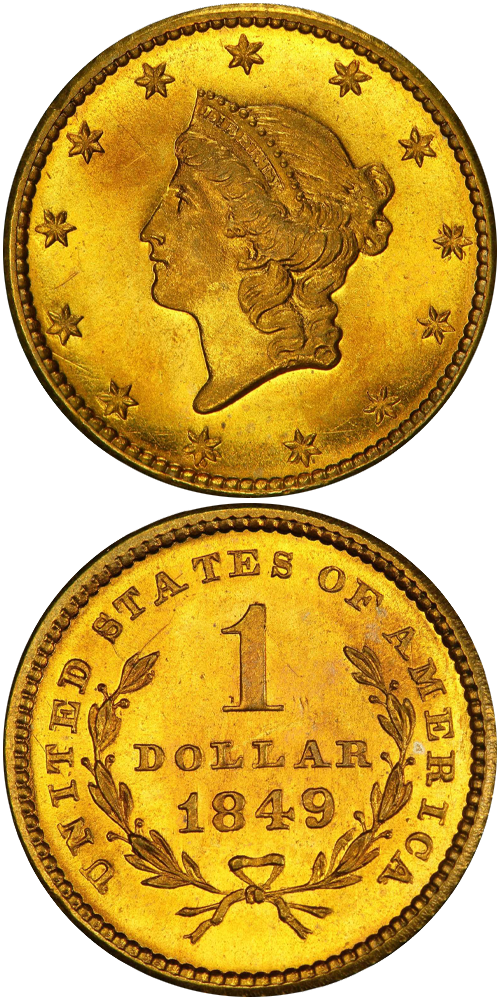1849 Gold Dollar
No
Originally proposed by Alexander Hamilton in 1791, the gold dollar was an integral part of his coinage scheme. However, the silver dollar ended up being the coin of choice for the initial American coinage starting in 1794. Due to ever-changing market conditions between the relative value of gold and silver, the silver dollar ceased coinage in 1803 (although a few more were reportedly coined until 1805, these are believed to be dated 1803).
The discovery of gold in Rutherford County, North Carolina induced Christoph Bechtler to begin coinage of a gold dollar in 1831, as the remoteness of the North Carolina mines precluded safe shipment to Philadelphia of gold bullion for coinage. Recall that the Philadelphia Mint was the only operational Federal Mint at that time. Curious too is the fact that Bechtler’s mine was one of the most productive and richest gold mines in America at that time. Bechtler did what any true American would do, he coined his own gold into dollars and other denominations which were widely accepted in that region. This competition did not go unnoticed by the Philadelphia Mint. By 1835, plans were hatched to open new Federal branch mints in both Charlotte, North Carolina and Dahlonega, Georgia, both of which came to pass in 1838.
When Christian Gobrecht joined the Philadelphia Mint in 1835 as the Assistant Engraver to ailing Engraver William Kneass (who soon thereafter died from complications of a stroke), Gobrecht designed his own versions of a gold dollar coin, which were struck in pattern form and listed as Judd-67 through Judd-71 using the older manual screw coining press, although it is not entirely out of the question that these pattern gold dollars may have been struck on the new steam press, installed in March 1836. Medals commemorating the first coinage from the steam press were coined by the Mint and dated March 23, 1836 and it is believed that these gold dollar patterns were struck starting on or before March 14, 1836 as one was sent in a letter so dated from Mint Director Robert Patterson to Secretary of the Treasury Levi Woodbury on that date (Breen and also Pollock).
A new coinage bill was sent through Congress for approval which included the new gold dollar denomination in 1836, however, when the bill was passed with modifications, the authorization for a gold dollar had been removed. This bill became law on January 18, 1837. Apparently Mint Director Patterson adamantly opposed a gold dollar coin, and used his considerable political clout to have this clause removed from the revised coinage bill of 1837. When the House Ways and Means Committee again proposed to make gold dollars in 1844, Patterson responded that they would be easily counterfeited and went so far as to have silver patterns made from Gobrecht’s original 1836 pattern gold dollar dies, and have the silver coins gold plated. Patterson won again, and the gold dollar proposal was again shelved.
However, history was about to turn the tide against Patterson. Gold was discovered in California in 1848, and by 1849 large quantities were being shipped to eastern mints for coinage. Silver coins were in great demand, and they increased in value as compared with gold because of the flood of gold coming from California. Representative James Iver McKay from North Carolina introduced a bill on January 25, 1849 to authorize coinage of a gold dollar, and later amended this bill to include a twenty-dollar gold coin. Patterson again opposed this legislation. At that time, America suffered from high unemployment, a lack of silver coins in circulation, and abundant wildcat banknote scrip, often of little value which would be accepted at a discount to face value at best. Congress had to do something, and they did. Congress passed McKay’s coinage bill and it became law on March 3, 1849. Mint Engraver James Barton Longacre designed the new gold dollar in early 1849. The Dr. Tory Prestera Collection 2007
On May 7, the No L 1849 gold dollars were struck from one obverse die paired with two reverse dies. Those two reverse dies were found to have cracked easily leading to some minor modifications to the obverse hubs. At the same time Longacre added his initial L on the truncation of Liberty's neck. This variety comprises a tiny fraction of the 688,567 coins produced in 1849.
The example to the left was sold by Stack's Bowers Galleries in the D. Brent Pogue Part VII Auction, where it realized $26,400.






